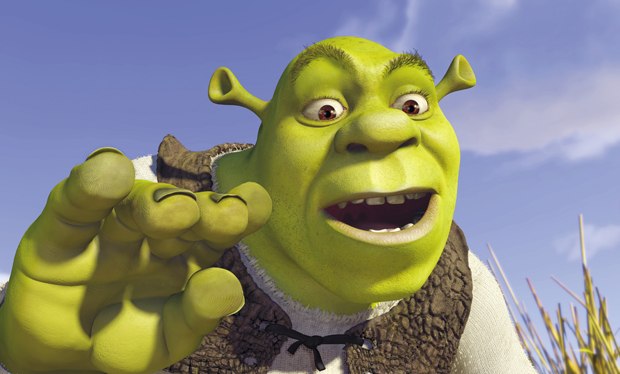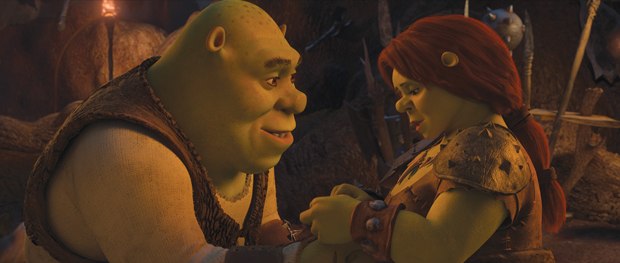Read how technology at PDI and DreamWorks Animation has evolved throughout the Shrek franchise.
Check out the Shrek trailers and clips at AWNtv!
Look how far Shrek has come in a decade: From a simple green ogre to a thing of beauty in Shrek Forever After, the fourth and final installment in the phenomenally popular DreamWorks Animation franchise (opening Friday through Paramount ).
Thanks to technological advances at PDI/DreamWorks in Redwood City and the DreamWorks Animation campus in Glendale (where Forever After was made to inject fresh blood), Shrek has continued to raise the bar in CG character animation and simulation for hair, fur, cloth, fire, water and global illumination.
Just think: there were 600+ character controls in Shrek compared to nearly 850 for Shrek 2, 1,083 for Shrek the Third and more than 1,200 for Forever After.
"There has always been the Shrek path of doing things and then all of the other shows, so one of the key things I did early on with rigging was add more squash-and-stretch to give it more life and make the characters seem less like puppets," explains Jason Reisig, head of character animation on the fourth Shrek.
"We retrofitted the Shrek characters to have the new skeletal structure that we've been developing, which allowed the characters to be looser and more expressive and more natural. Shrek's spine had always been very rigid and when he's flying around the broom chase, he gets into stretched out poses for the first time. But you have to be careful with Shrek's face because it looks weird and goes off model quickly. However, with Rumpelstiltskin, there were no barriers: he's an exaggerated personality."
According to Darin Grant, head of production technology, there's an ear trumpeting gag introduced by Shrek and the other ogres that never could've previously been done as a result of the retrofitting. "There's a line, 'I didn't know we could do that,' which turns out to be true because on Shrek his ears had to be individually animated, and then on Shrek 3 we developed some secondary motion systems to allow the ear movement to be more simulated based on head movement."
Meanwhile, Puss in Boots has three rigs in Forever After: one for the normal Puss, another for the fat Puss in the alternate reality that Shrek has been tricked into experiencing and a bi/quadped so he can go from one stance to the other.
Speaking of the swashbuckling feline, who has his own Sergio Leone-inspired animated feature next year, he required an upgrade in the fur shader for his introduction in Shrek 2. Not only that but there were two shaders for the feather plume in his hat and a new simulation system for automatically getting the cat's fur out of the way of his belt, which was hand-animated.
"I think one of the notable pieces in Shrek 2 was the shampoo hair shot of Prince Charming," Grant recalls.
Clothing too saw a big upgrade in Shrek 2, blending from a procedurally-driven, tight-fitting top to a simulated skirt using the proprietary Emo and Maya. The studio also developed a new fabric shader dealing with threads running in different directions and allowing them to go from cotton to satin to silk.
There was also a noticeable advancement in fluid simulation on Shrek 2 for the From Here to Eternity riff between Shrek and Fiona. Whereas Shrek merely offered a glass of milk, the sequel offered dozens of layers of water elements by animating particles for the waves as well as various splash layers on top of them.
But the crowning achievement of Shrek 2 was the introduction of global illumination. The studio developed a bounce light technique that, given a key light, automatically computes the correct bounce light off of the other objects in the scene. They would then add additional fill light and tweak it from there.
Yet overcast lighting was hard on Shrek 2, so there were additions to the global illumination pipeline for Shrek the Third. Other improvements in Shrek the Third included new character rigs with improved facial animation for better performances; more tactile clothing and fabrics with multiple areas for simulating movement; long and bouncy hair for all of the princesses that didn't take months to render; more effective fire and water engines; more controllable crowds; and greater and more beautiful environments.
"In Shrek 3 we used global illumination except for those sequences with high complexity because it was too time intensive," Grant adds. "But on Shrek 4, we were able to use global illumination to its fullest extent throughout the forest and throughout all those ogre battles and then also through all the hair styles. We have this technique similar to point-based color bleeding called point-based global illumination and it was first introduced on How to Train Your Dragon. But now you got to see that technique applied to all of the Shrek environments in Shrek 4. It's given us the ability to be less limited by what our renderer is capable of and be more focused on trying to put the best image quality out there.
Hair simulation has continued to improve in the Forever After. For instance, there's a key shot of Fiona as the warrior princess where you see her hair flowing in the wind. "Actually, her hair flows and cascades throughout, so the main thing there was it became less of a one-off and more of a standard process," Grant continues. "The other nice thing is that the process before for setting up the hair required a lot of different departments: modeling, surfacing, character effects all working together. But for Fiona, her hair set up was done by one group, which allowed the process to be optimized and work across many, many shots.
"With cloth, the differences between Shrek 3 and Shrek 4 are about making things easier to integrate across the entire film rather than achieving great one-off shots. It may not be as obvious to see but more obvious in terms of our production pipeline. With cloth we had a big challenge on Shrek 3 with lots of multi-layered cloth set ups and costumes because of the emphasis on royalty. What you saw on Shrek 4 was the ability to take some of those multi-layer cloth set ups and spread that across not only the hero characters but also among the secondary characters. The ogres all had their own unique clothing set ups. Personally, I think if you look at some of the secondary characters and crowd scenes in Shrek 4, you see a big difference in quality that has a lot to do with putting some of that technology in secondary areas."
In terms of effects, there has been dramatic improvement throughout the franchise. In Shrek, there were limited effects -- milk for dunking Gingy and straight Maya fluid simulation for the fire and torches. On display in Forever After are new fracture tools.
"Once again, because Dragon and Shrek 4 were right on top of each other, we got the benefit of looking at different tools that would be used across both films and be able to push them out," Grant says. "So the same fracturing tools that you saw shattering the side of the mountain at the end of Dragon were used in a different way on Shrek 4, allowing our effects artists to crumble a cookie. A lot of our film takes place at night this time, and where torches used to be a challenge, they are a matter of course here. There are 35 different torches just in the over camp section alone.
"And we had some big effects payoffs. There are three different effects layers going in and out of the alternate reality. The filigree effect, where characters disappear in a flourish, comprises the foreground layer. In the mid ground, you see the world tearing apart with thousands of pieces of paper. And the background element consists of an organic tornado as the world fades. That tornado is generated with 500 million particles. These new effects added to the complexity and provided richer visuals. Again, it's always been about putting the best image quality out there."
Bill Desowitz is senior editor of AWN & VFXWorld.












